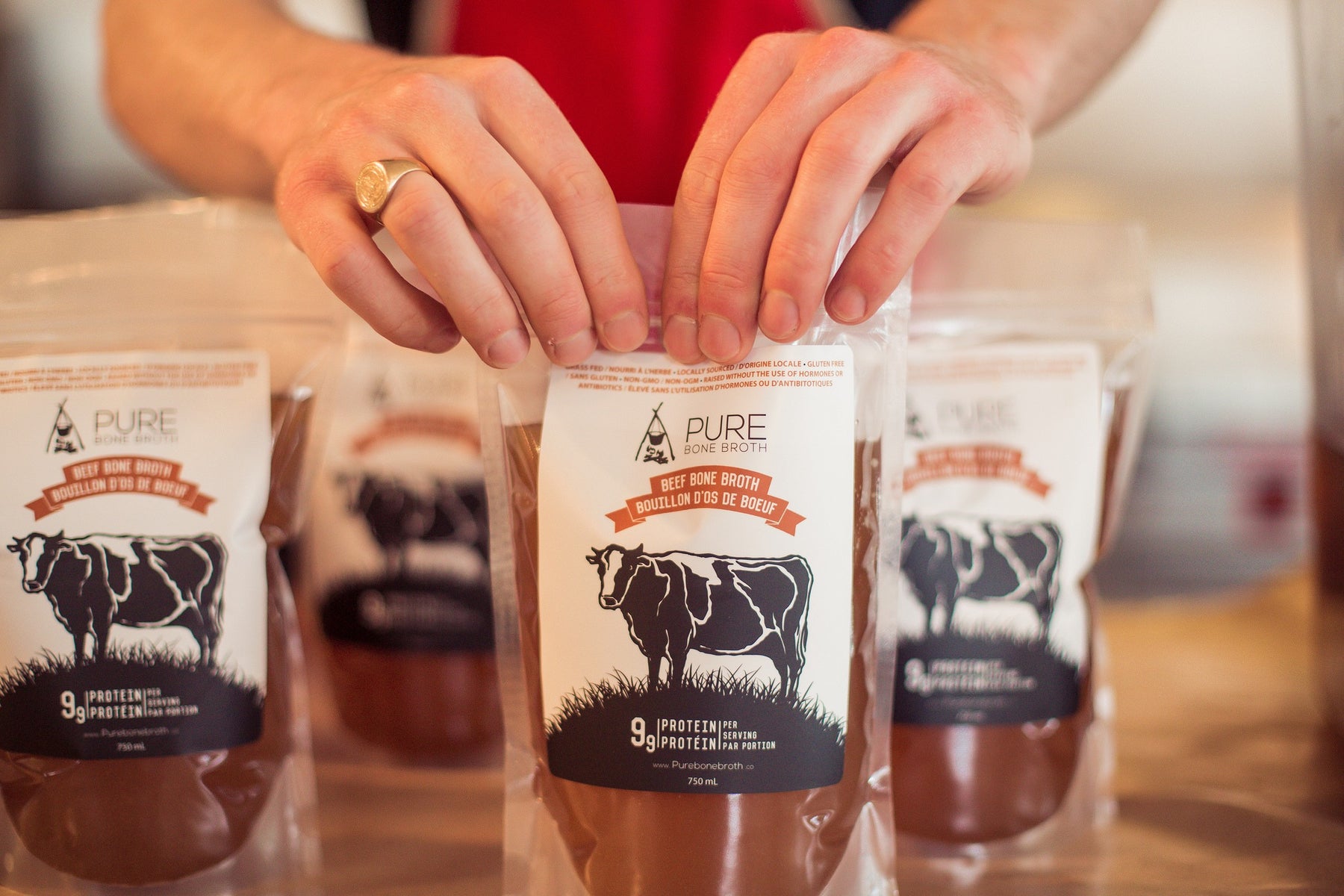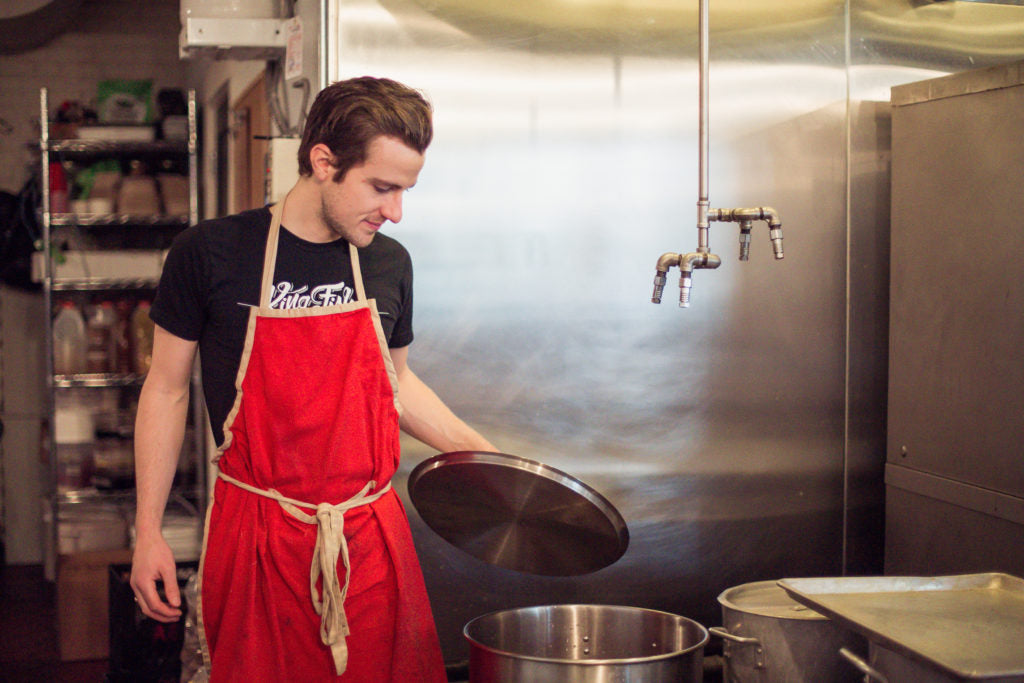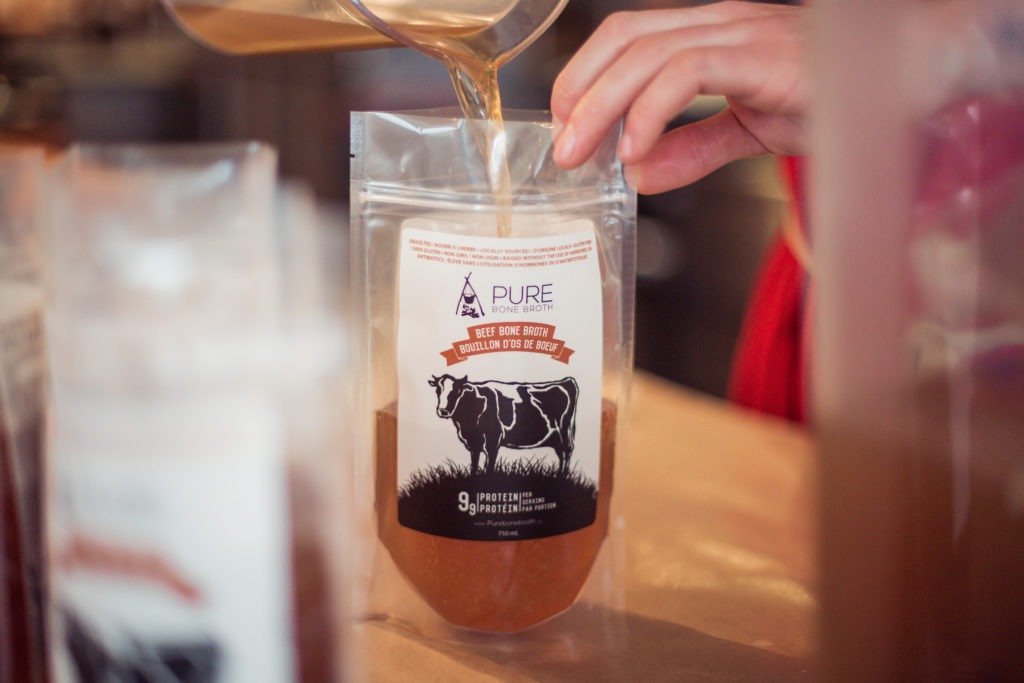
The first 100 days: Pure Bone Broth
It’s been a wild year for Connor Meakin. It was barely three months ago that the 27-year-old launched Pure Bone Broth, Vancouver’s first commercial retailer of chicken and bone broth. The launch followed months of testing and research—not to mention years of experience that would inspire Connor and guide his growth as an entrepreneur.
At age 17, Connor made the Canadian men’s national field hockey team. He spent four years training and traveling to countries like Russia, India, Australia and South Africa. During that time, he completed a degree in cognitive psychology—mostly by correspondence—and in his final semester began an internship at Hootsuite. He ended up spending four years with the startup as it became one of Canada’s leading tech companies, before leaving his job in June 2015.
While taking some time off, Connor got into his head the idea of making and selling bone broth. It was a product he had been interested in for a long time, particularly for the way it helped treat his sports-related pain issues. He spent six months researching various bone broth companies in the US, while making batches of broth every night at home. Finally, in January 2016, he decided to start it as an online business.
We chatted with Connor near the end of March, right around the three-month mark of his starting the business. He gave us a great look into the process he went through to get it off the ground, from his initial research to his first orders to his next steps as a business owner. In the first post of a new series we’re calling “The First 100 Days,” we’ve broken down our chat with Connor to illustrate his first steps as an online merchant.

The Beginning (Day 0)
“This bone broth thing was always in the back of my head. I became passionate about some of the ways it made me feel, how it helped clear up some chronic pain issues I was dealing with from a lot of different sports. I became pretty stoked on what it can do for you, and I wanted to find a way to share it with other people."
Product Development (Days 1-30)
“This was a big part of the research I did. I wouldn’t be comfortable doing this if I couldn’t get the product right myself. I’ve made almost 100 batches of bone broth over the last six months. I have them all on a spreadsheet. Every night I would have a different test batch going in my kitchen at home. I was experimenting with a lot of different bones.”
Target Demographic (Days 1-7)
“I came up with a few buyer personas. The first was women aged 40 and up. A lot of people who find bone broth have it recommended to them by a naturopathic physician or holistic doctor. Many of them are patients with Crohn’s, Colitis, Celiac, etc. The second and third personas were young, active, professional males and females aged 25 to 35—people who are very conscious about what they eat, who try to stay healthy.”
Naming Process (Days 1-7)
“I came up with a bunch of names I liked, and then I got it down to around 10. After that, I polled about 50 friends, and they helped me get it down to a top three. Once I had my top three, I used an online polling service called PickFu to poll users in my target demographic. The top result ended up being Pure Bone Broth, so that’s the one I went with.”
Corporate Registry (Days 8-14)
“I incorporated myself instead of getting lawyers to do it in order to save some money. Along with my corporate registry, I got my GST number and business license to operate in BC.”
Supply Chain (Days 1-14)
“I got the supply chain set up in about two weeks. Vegetables and herbs were fairly easy. The biggest thing was finding bones—beef bones, especially. I cold-called pretty much every organic farm in British Columbia. I started talking with the farmers, asking them about their farming practices. One of our brand’s core values is sustainability. We work with small-scale farms that raise their animals in a low-stress, natural environment. After calling all these farms, I was only able to find two or three that fit my standards, and of those that did, only one was prepared to sell me the volume of beef bones I was looking for."
“The Point of No Return” (Day 15)
“The farm I’m working with is in this little bush town called Horsefly. They deliver to Vancouver once a month. When my first shipment came in—150 kilograms of beef bones—I had nowhere to put them because I didn’t have my kitchen yet. I ended up having to buy a massive deep freezer off of Craigslist, and I stored all these bones in my apartment. That’s when it really hit me, because that was my first massive expenditure. Incorporating was fairly cheap, but these bones were $7 a kilo. That was kind of the point of no return for me.”
Commercial Facilities (Days 15-30)
“I looked at about half a dozen commercial and commissary kitchens for production—that’s about all there is in Vancouver. It’s a legal requirement, so I knew from the start that was going to be a fairly significant expense. I started negotiating with a few of these kitchens, and I found one that I really liked with people I really liked. We negotiated for about two weeks, and then after that I had to wait about two weeks for my lease to start.”
Kitchen Equipment (Days 15-30)
“You need lots of massive pots to make bone broth. I started gradually buying that stuff, finding places online to get it cheaper. I recorded all those costs in a spreadsheet.”
Budgeting & Pricing (Days 20-30)
“I put all my budgets together in Google spreadsheets with monthly expenditures, how much I was spending on kitchen equipment, my supply chain for bones and produce—basically how much a whole batch of this broth was going to cost me to make. After that, I started digging into pricing, and how much I could charge for it based on the existing products that are out there. I had to make sure I could maintain a decent margin and make a decent profit.”
Branding & Design (Days 15-45)
“I knew a few designers locally, but they weren’t quite the right fit. I was referred to a designer from Toronto, and she and I kind of hit it off. We started going back and forth on a lot of the branding, the logos, the packaging, that kind of thing. This whole process took around a month, once we were done going back and forth with all this kind of stuff.”

Packaging (Days 15-30)
“We package the product in plastic food-safe pouches with ziplocs on the top. I got this idea from some other companies in the US that make bone broth. For our packaging, I got quotes from a bunch of different companies, from places in China to local companies as well.”
Food Safety (Days 15-30)
“There's a lot of bureaucracy and red tape around marketing a food product in Canada—for good reason. As a consumer, it's comforting to know that there are these hoops to jump through. As a producer, though, it's very confusing. There's no real resource to walk you through how to do this. I ended up spending a lot of time calling government agencies, trying to get them on the phone, waiting five days for them to get back to me, that kind of thing. Even just trying to figure out which paperwork I had to apply for was a huge challenge."
Nutritional Analysis (Days 30-40)
“It’s not mandatory in Canada, but I decided I wanted to get nutritional analysis done on my product. This is what goes on the nutrition label—calorie content, fat content, minerals, all that fun stuff. So I made a batch and shipped that off for nutritional testing. It takes 10 business days for them to complete it, which had me freaking out because I needed to finish my packaging to send it to the printing company to get printed. This was the only thing holding that up.”
Label Approval & Printing (Days 40-45)
“Eventually the nutritional analysis got done, but we hit a couple snags with the label along the way. Basically, I would get the designer to do the label with what I thought was going to be perfect, but then I would run this by our local health authority… they’re very finicky in terms of what you can put on a nutritional label. With Canada being a bilingual country, everything has to be in French, and there's all this stuff about the health claims you can make. I had a lot of back and forth with our local and federal health inspectors, making sure the label was legal and up to standards. After all that, finally, I got the labels printed by a local printing company.”
Ecommerce Research (Days 15-50)
“I didn’t really know anything about ecommerce, but I knew a fair bit about online marketing and social marketing. There’s a lot of overlap. I started immersing myself in the world of ecommerce, consuming every piece of content I could find about building and marketing an ecommerce business. It’s slightly embarrassing to admit this, but I’ve probably listened to around 400 hours of ecommerce podcasts since I decided to start the business.”
Theme Research (Days 21-35)
“I knew Shopify was kind of the hottest game in town for ecommerce, so I started looking into different themes that would fit my needs. I had it down to a couple different themes, and it wasn’t until I randomly discovered the Startup theme that I decided to scrap the other two themes and go with this one.”
Building Web Content (Days 35-50)
“After finalizing my theme, I started building content for the website, as well as all the social accounts. I don't really know much about HTML or CSS, so it was definitely a learning process. Any custom edits was a complete shitshow with me trying to copy and paste code.”
Website Launch (Day 50)
“It was supposed to be a pretty soft launch. As part of it, I gave some sample products to an old friend of mine who runs a website called Vancouver is Awesome. He was like, ‘Oh yeah, I'll write a story about this sometime.’ I was expecting him to maybe write something in a couple of weeks, but he really liked the broth and ended up publishing a story that afternoon. I didn't realize how much traffic they get on that website, but overnight I ended up getting a shitload of orders, and well into the next three days. Fortunately, I was prepared for in terms of inventory and product, but it was definitely overwhelming.”
Shipping (Days 51-100)
“The product is delivered and shipped frozen, which is a good thing and a bad thing. It's good in that it greatly extends the shelf life. It’s shelf-stable for 7-10 days in the fridge, but frozen it's good for six months. What that means is some unique logistical hurdles when shipping or delivering... Luckily, before the first rush hit, I had ordered a bunch of insulated styrofoam containers based on research I had done on companies like U-Line, and from talking to other bone broth companies. They’re designed for medical supplies and food, and they’re rated to keep cold for 48 hours. I put the product in there with dry ice, and if I’m shipping it I put that inside an outer box which gets all the shipping info.”
Local Delivery (Days 51-100)
“I haven't been shipping too many units—mostly it's been local delivery. The local demand has been good enough that I haven't had to go after too many other markets. I started doing deliveries myself right from the beginning, two days a week. I just load my car up with a bunch of these styrofoam containers and do the deliveries. Sometimes I end up in a car for eight hours that day, which isn't the greatest. The first thing I outsource is probably going to be a driver or a local delivery service.”

Repeat Customers (Days 75-100)
“A lot of people are buying five or six units at a time because they can freeze it, and that'll last them for two to three weeks. I’m at an interesting stage now where I'm getting a lot of people's second and third orders. I've thought about putting a subscription button on the website but I haven't quite gotten around to it yet.”
Retail (Days 75-100)
“I'm slowly building out the retail presence here. I'm being very strategic about it, only working with retailers whose values are in line with our brand’s values. So you won't see it anywhere that's not in line with the natural food movement… I do like direct to consumer, but I'm having a hard time wrapping my head around scaling to see any appreciable value without having the distribution of retailers. I'm still struggling with it, going back and forth with it, but I realize that I'm going to need some retail help if I want to build this into a brand.”
Funding (Days 1-100)
“I would say 80 percent of my time has been spent on starting and growing the business, and the other 20 percent has been spent doing online marketing consulting, which pays my mortgage and rent and some other bills while I’m scaling this up.”
Next Steps (Days 100+)
“Production and distribution are the two main things on my mind right now. I’m also working on figuring out the retail side of things, and just keeping on top of demand and supply. If things scale up like I hope, I’m going to outgrow this commercial kitchen space, so I’m also looking into some options there, whether it means building my own kitchen or finding another solution.”
–
Since we first chatted with Connor back in March, he’s continued to build on what’s working, experimenting with email marketing campaigns and scaling up production. In April, he hired his first employee to help in the kitchen. When we caught up with him last week, he told us he’s been spending a lot of time looking into co-packing solutions that would help him outsource production completely.
"Once you hit a certain scale, it's just not feasible to keep using a kitchen space or building your own kitchen," he said. "The difficulty for us is finding the right solution, because our product is such a niche product, and it takes a long time to make—at least 24 hours at a low heat. Still, these co-packing facilities are kind of the industry standard. They're a cost-effective way to keep the quality high as you scale."
Retail opportunities also continue to expand for Connor, with the product now sold in a number of stores around Vancouver. He estimates his split between online and retail sales to be around 50-50—though with the product expected to hit the shelves at Whole Foods "any day now," that figure could begin to skew towards retail.
Whether you're selling online, in-person, or both, Connor's progress in just a few months should be an inspiring story for all first-time merchants. We'll definitely be keeping an eye on him, and hoping for even more good news to come.
To learn more, head over to the Pure Bone Broth website.
Pure Bone Broth uses Pixel Union’s Startup theme.